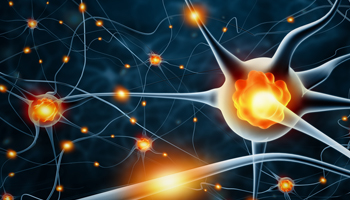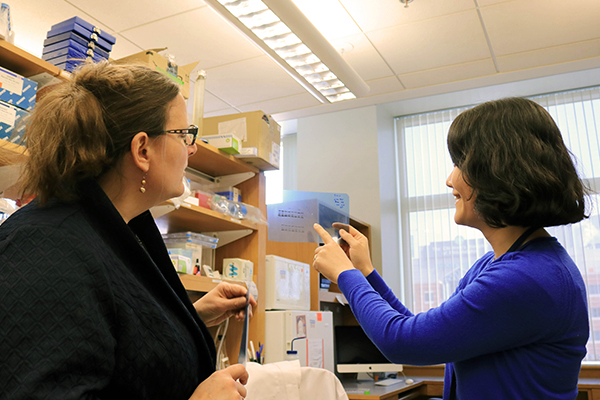HOW CAN WE HELP YOU? Call 1-800-TRY-CHOP
In This Section
Researchers Target Brain Circuity as Driver of Antidepressant Behavior
 Neurobiology researchers at Children’s Hospital of Philadelphia are looking deep into the brain’s circuitry to search for new avenues for the treatment of major depressive disorder, the most common mental illness.
Neurobiology researchers at Children’s Hospital of Philadelphia are looking deep into the brain’s circuitry to search for new avenues for the treatment of major depressive disorder, the most common mental illness.
In 2016, 10.3 million adults had at least one major depressive episode with severe impairment, according to the National Institute of Mental Health. While care by a health professional and antidepressant medication may be effective for some people, current treatments have a high rate of relapse and side effects.
CHOP’s study team from the Department of Anesthesiology and Critical Care Medicine collaborated with their scientific colleagues to investigate the underpinnings of depression as a “circuitopathy” that is linked to dysfunctional brain circuits. In Nature Medicine, they published preclinical findings from animal studies that suggest a circuit-based approach that uses brain stimulation to precisely “tune” a specific circuit could one day be a novel way to combat the behavioral symptoms of major depressive disorder.
The idea for the study came as an “aha moment” to first author Sunghee Yun, PhD, who also is a research assistant professor at the Perelman School of Medicine at the University of Pennsylvania, when she was reviewing scientific literature on animal and human research that showed stimulation of the entorhinal cortex (Ent) improved learning and memory. The Ent is one of the brain’s critical information hubs and a main interface to the hippocampus that is associated with memory and mood regulation.
“Many neuroscientists are looking at which brain regions are disturbed during depression,” Dr. Yun said. “The hippocampus is known as a memory circuit. But we wanted to target how this memory circuit may improve mood regulation as well. No one had considered before if stimulation of a circuit shown to improve memory also would improve mood.”
 Dr. Yun tested her hypothesis in the CHOP Research Institute laboratory led by neurobiology researcher Amelia Eisch, PhD, who also is a professor of Anesthesiology and Critical Care at Penn with a secondary appointment in the Department of Neuroscience. They designed the study to assess whether Ent stimulation is antidepressive in mouse models of depression. Previous research had shown that directly stimulating the hippocampus region was not effective or made memory worse, so the investigators used molecular and chemogenetic techniques to target specific circuits in the Ent that are upstream from the hippocampus.
Dr. Yun tested her hypothesis in the CHOP Research Institute laboratory led by neurobiology researcher Amelia Eisch, PhD, who also is a professor of Anesthesiology and Critical Care at Penn with a secondary appointment in the Department of Neuroscience. They designed the study to assess whether Ent stimulation is antidepressive in mouse models of depression. Previous research had shown that directly stimulating the hippocampus region was not effective or made memory worse, so the investigators used molecular and chemogenetic techniques to target specific circuits in the Ent that are upstream from the hippocampus.
For the molecular approach, Dr. Yun studied the disruption of a channel protein in the Ent-hippocampal pathway called TRIP8b that usually increases during stressful conditions (stress is related to depression) and inhibits cell firing. In mice genetically engineered to “knock down” or eliminate TRIP8b, their Ent neurons were more likely to fire and produce new hippocampal neurons at a faster rate. The mice also demonstrated antidepressive-like behavior and improved memory in a battery of tests that measured the animals’ anxiety, motivation, and stress levels.
“The TRIP8b channel tightly regulates when a cell fires and how it deals with incoming information,” Dr. Eisch explained. “Our general thought is that maybe when you’re stressed or depressed, that these cells are quieter. So if we stop the channel that lets ions flow across the cell membrane, then maybe the cell will fire more. And maybe firing more will be helpful to improving memory and improving mood.”
While this study’s results suggest that stimulating the Ent- circuitry spurred neurogenesis and drove antidepressive-like behaviors in laboratory mice, scientists are just beginning to understand how this approach eventually could be used to fine-tune memory and mood regulation in humans.
“This is a first step, so there is much research to be done to determine if we can translate this knowledge into practical, noninvasive treatments for people with depression,” Dr. Eisch said.
The researchers pointed out that this study used an animal model that represents a young adult’s brain. They don’t know if this new strategy would apply throughout the lifespan as the brain changes from childhood to the aging population, and depression may manifest differently at these different life stages. Drs. Yun and Eisch also are eager to explore how circuit-based controlled stimulation could be used to better understand psychiatric disorders that share symptoms of hippocampal dysfunction, such as bipolar disorder and post-traumatic stress disorder, and other conditions with cognitive deficits and mood dysregulation, such as Down syndrome and Alzheimer’s disease.
As Dr. Eisch’s lab builds evidence on the power and potential of Ent- stimulation, they are looking for translational research collaborators to explore how this approach could one day be harnessed through clinical treatments to improve mood more effectively.
“We’re experts on the preclinical side, but we need partners to help us with asking the right questions, and CHOP and Penn is great place to do that,” Dr. Eisch said. “Remarkable neurostimulation work is going on here in humans. I’m hopeful that as technology advances, we can develop something hand-in-hand with our clinical colleagues that is circuit-based and safe.”